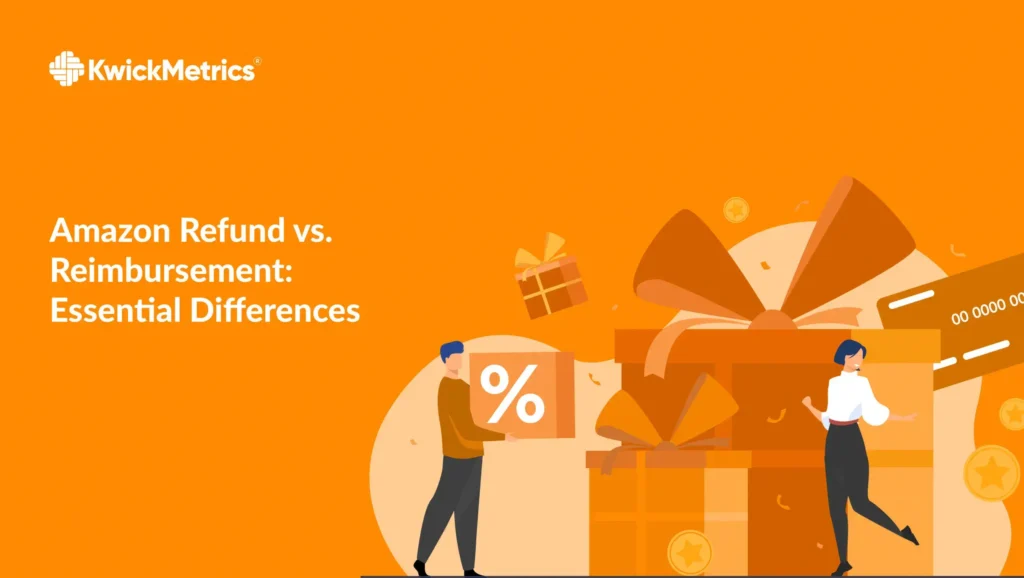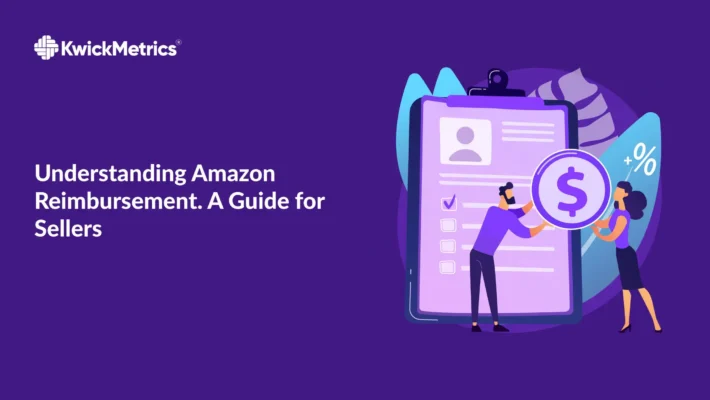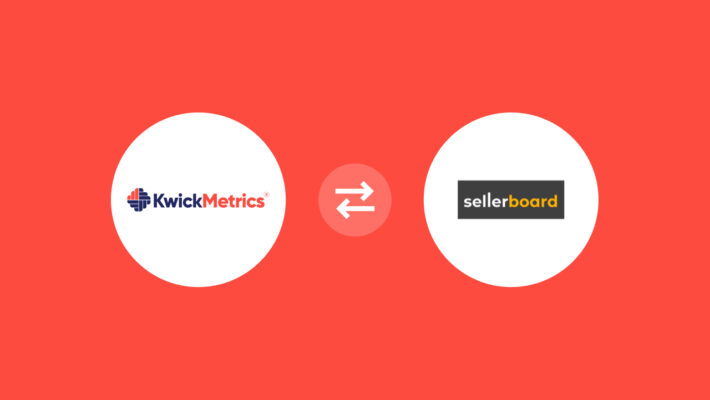Amazon Refund vs. Reimbursement: Essential Differences

Table of Contents
- How does Amazon assess the condition of returned items at Fulfilment Centers?
- Check How Much Money You Deserve to Get Back!
- How does Amazon handle the disposition of returned items in the refund cycle?
- Amazon Reimbursement Options
- Settling Refund Conditions
- Expected Reimbursement Timeline
- Statutes of Limitation for Reimbursements
- Amazon’s Private Label Reimbursement Tactics
- Seller Margin Impact: Amazon Reimbursement
- Amazon Refund vs Reimbursement
- FAQs In relation to Amazon reimbursement vs. refund
- Conclusion
- Try our Amazon Analytics Tool with a 14-day Free Trial!
In the intricate realm of Amazon transactions, sellers often grapple with the intricacies of customer refunds and seller reimbursements. This comprehensive guide aims to unravel the stages of the refund cycle, explore reimbursement options, delve into the settlement of refund conditions, and shed light on the nuances of reimbursement processes. Understanding the distinctions between refunds and reimbursements is vital for sellers seeking to optimize their operations, maintain profitability, and ensure a seamless e-commerce experience.
How does Amazon assess the condition of returned items at Fulfilment Centers?
In instances where a customer expresses dissatisfaction with a purchase, the following sequence unfolds:
Customer Initiates Refund: Amazon responds to customer dissatisfaction by initiating a refund process.
Return to Fulfilment Centre: The customer is required to return the unsatisfactory item to an Amazon Fulfilment Centre.
Condition Assessment at Fulfilment Centre (FC): Amazon meticulously assesses whether the returned item is in a sellable condition.
Inventory Status Determination:
- Sellable Condition: Items meeting sellable criteria are returned to the seller’s inventory as fulfillable, with no entitlement to compensation.
- Non-Sellable Condition: If the item is not sellable, Amazon determines responsibility for damage.Amazon Reimbursement Scenarios:
Amazon Takes Responsibility: In the event Amazon assumes responsibility, the item is disposed of, and the seller becomes eligible for reimbursement.
Amazon Does Not Take Responsibility: In cases where Amazon declines responsibility, the item is returned to the seller’s inventory as unfulfillable, with no compensation.
Check How Much Money You Deserve to Get Back!
How does Amazon handle the disposition of returned items in the refund cycle?
-
- The customer obtains a refund from Amazon.
- The customer returns the unsatisfactory item.
- The item is either returned to the seller’s inventory (fulfillable or unfulfillable), with no compensation due, or it is disposed of, warranting reimbursement.
Amazon Reimbursement Options
When inventory faces loss or damage under Amazon’s control, whether during transportation, within fulfillment centers, or in customer delivery, Amazon offers two resolution options. They may replace the affected items with the same FNSKU or compensate the seller by paying the evaluated replacement value. However, in the latter case, Amazon deducts applicable fees related to both FBA and Selling on Amazon. Sellers need to be aware of fee reimbursement details, including considerations for Amazon FBA refund and seller reimbursement processes, to ensure a fair and seamless resolution in cases of inventory issues.
Settling Refund Conditions
Refund resolution on Amazon entails either returning the item to the seller’s inventory in a sellable or unfulfillable condition or reimbursing the seller with an identical, fulfillable item. Amazon handles these processes seamlessly, extending the resolution framework to cover private label items. This approach effectively addresses concerns related to FBA returns reimbursement, providing a smooth and efficient process for sellers on the platform.
Expected Reimbursement Timeline
-
- A customer is obliged to return an unsatisfactory item within 30 days of requesting a refund.
- Amazon, upon receiving the item, necessitates an additional 15 days to process the reimbursement.
- Consequently, sellers should refrain from anticipating reimbursements before the lapse of 45 days since the customer refund date.
Key Takeaway:
Amazon provides two resolution options for inventory loss or damage: replacement with the same FNSKU or compensation at the evaluated replacement value. Sellers should be aware of the expected reimbursement timeline, which is approximately 45 days from the customer refund date.
Statutes of Limitation for Reimbursements
- Sellers should be cognizant of the fact that reimbursements cannot be claimed for refunds that transpired over 18 months ago.
Key Takeaway:
Sellers should be mindful of the 18-month statutes of limitation for claiming reimbursements. Additionally, the guide highlights the unique considerations for private label sellers, especially in scenarios where Amazon loses part of their inventory during processing, emphasizing the importance of understanding reimbursement tactics and their potential impact on seller margins.
Amazon’s Private Label Reimbursement Tactics
In the event of Amazon losing a part of a seller’s private label inventory during inbound or transfer processing, the resolution process is contingent on the initial reimbursement method. If the seller is initially reimbursed in cash, Amazon reserves the option to subsequently return the found items to the seller’s inventory, which could involve reclaiming the initial cash reimbursement. Alternatively, Amazon may choose to keep the found items separate, designating them for potential future in-kind reimbursements rather than opting for a cash refund. This approach provides flexibility in handling reimbursements based on the unique circumstances of the inventory loss.
Seller Margin Impact: Amazon Reimbursement
In cases where Amazon reimbursement occurs in kind, the unit returned to the seller’s inventory constitutes full compensation, necessitating a subsequent sale.
- If reimbursement transpires in cash, Amazon employs various criteria to calculate a ‘fair’ compensation amount (replacement value).
- Typically, Amazon reimburses a percentage of the order amount, seldom covering the full order amount. This practice may impact the seller’s margin for the returned order.
- Sellers must diligently assess whether they are still operating at a profit and if the profit adequately covers the Cost of Goods Sold (COGS).
- Additionally, sellers should bear in mind that, in most cases and depending on the product category, Amazon refunds referral fees and certain FBA fees.
Amazon Refund vs Reimbursement
| Criteria | Refund | Reimbursement |
|---|---|---|
| Initiation | Triggered by customer dissatisfaction or return request. | Initiated by Amazon for lost, damaged, or mishandled inventory. |
| Customer Involvement | Customer requests a refund for an unsatisfactory purchase. | Customer returns the item, but the process is initiated by Amazon. |
| Condition of Returned Item | Customer returns the item, and its condition is not always guaranteed. | Amazon assesses the condition of the returned item to determine reimbursement. |
| Inventory Status | Refunded item may or may not be returned to seller's inventory. | Reimbursement may result in the return of an identical item to seller's inventory or a cash payment. |
| Compensation | Refunded amount is typically the original purchase price. | Reimbursement may involve replacement with an identical item or a cash payment (evaluated replacement value, less fees). |
| Seller Control | Sellers have limited control over refund initiation. | Reimbursement options are at Amazon's discretion, and sellers have no say in the method chosen. |
| Processing Time | Refunds are typically processed within a certain timeframe. | Reimbursement processing time varies but may take at least 45 days from the customer refund date. |
| Statutes of Limitation | Refunds can be claimed within a reasonable timeframe, not subject to a specific statute of limitation. | Reimbursements cannot be claimed for refunds older than 18 months. |
| Purpose | Addresses customer dissatisfaction or returns. | Compensates sellers for lost or damaged inventory under Amazon's control. |
| Private Label Products | Applicable to any product sold on the platform. | Reimbursement may involve returning lost private label inventory either in cash or kind. |
Key Takeaway:
Sellers need to understand the fundamental difference between customer-initiated refunds and Amazon-controlled reimbursements. While refunds address customer dissatisfaction, reimbursements compensate sellers for lost or damaged inventory under Amazon's control.
FAQs In relation to Amazon reimbursement vs. refund
1. What is the difference between a refund and a reimbursement on Amazon?
A refund is initiated by customer dissatisfaction and involves returning the item, while a reimbursement is a compensation process for lost or damaged inventory under Amazon’s control.
2. How does Amazon assess the condition of returned items at Fulfilment Centers?
Amazon meticulously assesses returned items’ sellable condition; if the item is sellable, it is returned to the seller’s inventory, and if not, Amazon determines responsibility for damage.
3. What are the reimbursement options offered by Amazon for inventory loss or damage?
Amazon offers two options: replacing affected items with the same FNSKU or compensating the seller by paying the evaluated replacement value, with deductions for applicable FBA and Selling on Amazon fees.
4. What is the expected reimbursement timeline for sellers on Amazon?
Customers have 30 days to return unsatisfactory items, and Amazon requires an additional 15 days to process the reimbursement, making the expected timeline for reimbursements around 45 days from the customer refund date.
5. Are there statutes of limitation for claiming reimbursements on Amazon?
Yes, reimbursements cannot be claimed for refunds that occurred over 18 months ago, emphasizing the importance of timely reimbursement requests.
Conclusion
In the dynamic arena of Amazon commerce, a comprehensive understanding of the intricacies between amazon refunds vs reimbursements is imperative for sellers. By navigating the stages of the refund cycle, comprehending amazon reimbursement options, and grasping settlement processes, sellers can streamline operations, mitigate financial impacts, and ensure a positive and resilient presence within the Amazon marketplace. This comprehensive guide empowers sellers to make informed decisions, fostering adaptability and success in the ever-evolving realm of e-commerce.



